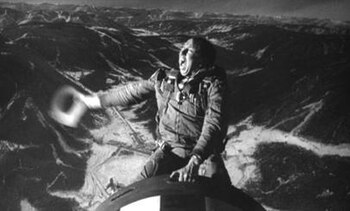 |
| Slim Pickens as Major "King" Kong riding a nuclear bomb to oblivion in Dr. Strangelove. (Photo credit: Wikipedia) |
Martin Esslin in his book the “Theatre of Absurd” (says) that absurdist theatre has renounced arguing about the absurdity of the human condition; it merely presents it in being- in terms of concrete stage images”. He indicated too, the influence of Camus’ Existentialism behind the absurd, with the idea that men are trapped in a hostile universe that (is) totally subjective, describing the nightmare that could follow when solitude and silence were taken to the ultimate degree.
Humour within absurdist plays is often found as black humour in which disturbing or sinister subjects like death, disease, or warfare, are treated with bitter amusement, usually in a manner calculated to offend and shock.
And here's an excerpt from an essay called "How Absurd Do You Like Your Art?"
Then there are examples of very absurd, senseless works of art that enjoy enduring popularity. This is captured in the category, “Absurdism,” in which the work of art doesn’t give solutions to the incongruity, and the audience is never expected to be able to resolve it. Only with Herculean efforts are people able to come up with their own, idiosyncratic interpretations, but often without any confidence that their own interpretation was the only right one. In the literature genre of Absurdism, the fact that it can’t be figured out is the whole point—communicating a message of meaninglessness in life.
Occasionally, feature-length Absurdist films are released, such as Matthew Barney’s The Cremaster Cycle, but more often the more absurd pieces are short—people just don’t have the attention span to watch hours of incomprehensible content. I remember when I was running a theater company in Atlanta, most plays would be sensible stories, featuring goal-driven protagonists, conflicts, climaxes, and resolutions. But when a show would feature a series of 11-minute plays, all the crazy stuff came out. We can see this on a larger scale with music video. With such a short time scale, directors are free to create something a bit wilder.
This spectrum of meaning in art has a corresponding spectrum of neural processing. It turns out that the kinds of things we like to experience are in a sweet spot between having recognizable patterns and incongruity. Too much of either one is boring. Too much pattern and we feel we have nothing more to get from it, and too much nuttiness and we lose any hope of finding an underlying pattern.
Two famous comic performers in a scene from an absurd play.

No comments:
Post a Comment